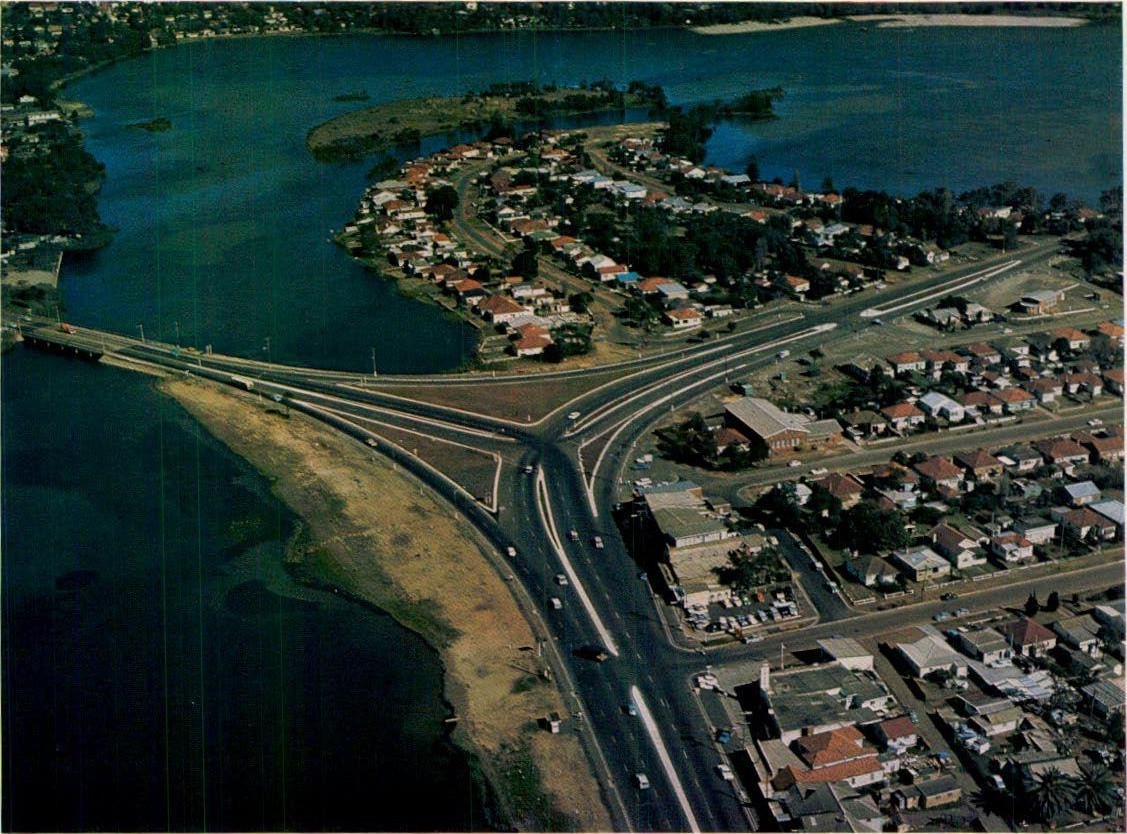Pictures From The Past: Views Of Early Narrabeen Bridges - 1860 to 1966
Did you know that Narrabeen's Lagoon did not have a bridge to cross into Pittwater until 1882?
People walking or riding on horses along the Pittwater road, formerly just a track, had to wait until the tide was low or choose what was known as a 'low part of the lake' near the site of the main Narrabeen Lagoon bridge today. The entrance to the lagoon was also frequently closed and that too could be a place to cross:
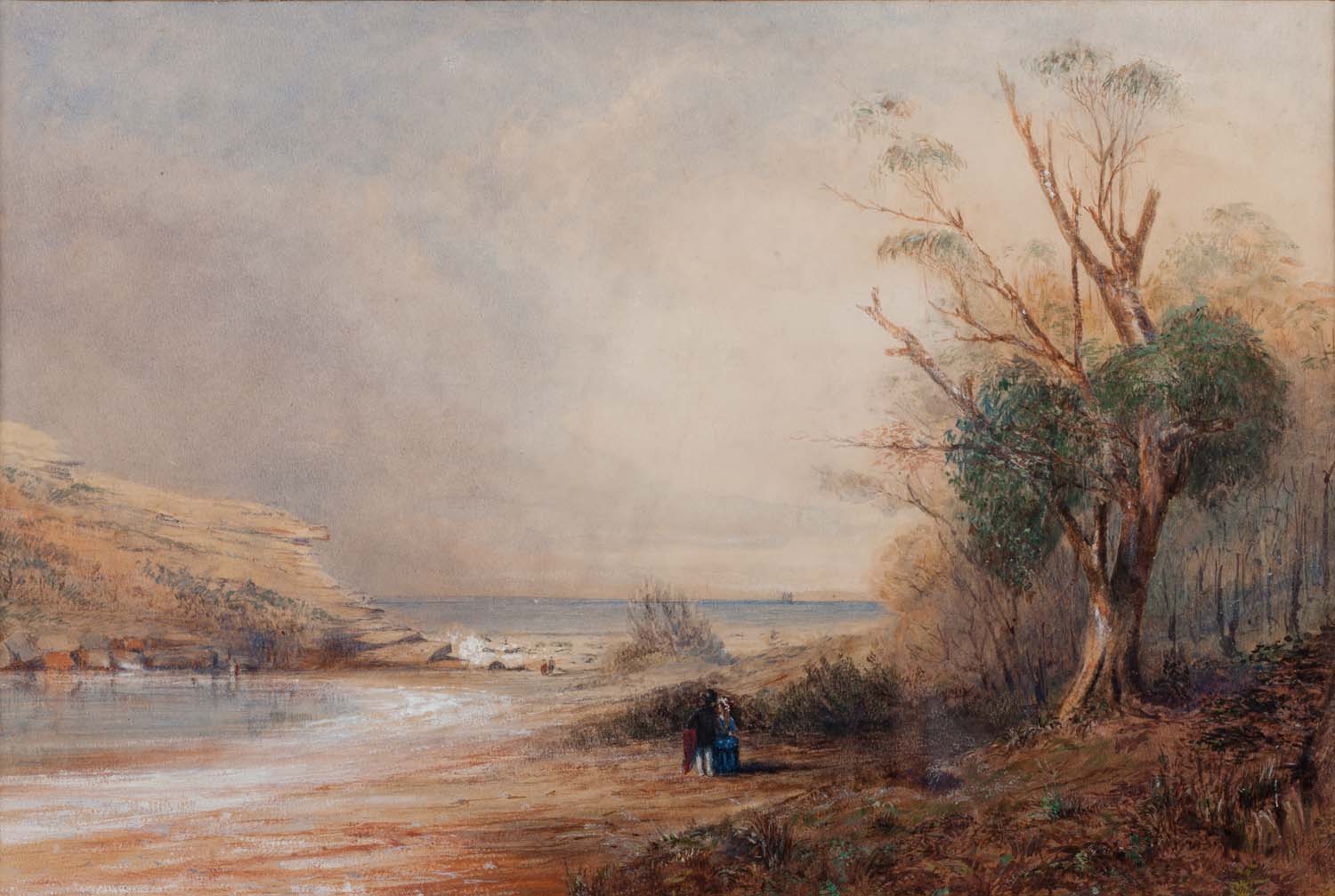
CONRAD MARTENS (1801-1878) Entrance to Narrabeen Lake, circa 1860 watercolour signed, titled and inscribed verso: Entrance to Narrabeen Lake by Conrad Martens 39.5 x 44.5 cm, courtesy The Alan & Margaret Hickinbotham Collection
Charles de Boos, in his published in 1861 account of walking from Manly to Barrenjoey, said:
The road now led us along a swampy honeysuckle flat for rather more than half a mile, and then brought us on to the margin of the Narrabeen lagoon. Narrabeen is a somewhat extensive lagoon, connected with the sea by broad sandy flats covered by the tide at high water, but hire at low water, with the exception of a distance of about twenty rods in width, forming a channel by which the surplus water of the lagoon runs out into the sea.
The opening to the sea is somewhat narrower than this, though deeper, taking a man to the waist in wading over, whilst at the regular crossing-place the stream at low water is not much over the knee. It is situated between the island fall of the high precipitous ridge that, jutting far out into the ocean, forms Narrabeen Head to the north; and to the south, the long low sandy beach that extends northerly from the Long Reef.
The large sheet of water that forms the lagoon is situated some two miles from the sea, with which the sandy flats connect it, although at high water, and particularly at spring tides, one broad expanse of water extending in one continuous sheet from the ocean into the interior for a distance of five miles is presented to the view, forming a magnificent lake, by no means wanting in picturesqueness and rude grandeur in some portions of it.
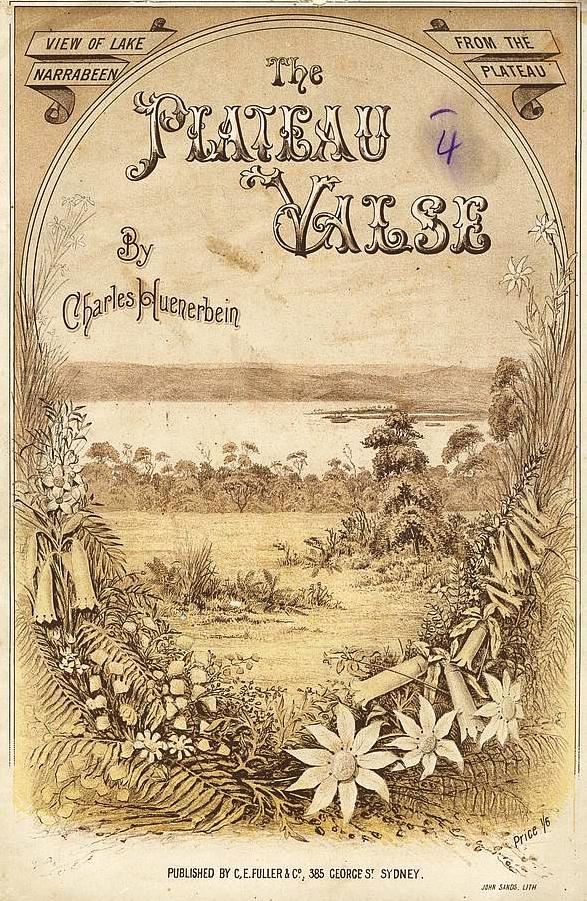 Where the road crosses, the country for some distance around is flat, and consequently tame, and the picture is rendered sombre by the low, thick growth of ti tree that fringes the water line, and the dark leaved honeysuckles of the flat land beyond ; but higher up, where the fresh water of the lagoon commences, where ranges clad with giant timber come down to its margin, and where numerous gullies with the rich, dank jungle vegetation of the tropics, including the cabbage-tree palm, the fern tree, the bengola, and wild vine, empty their watery contributions into it wild landscape views might be taken fully equal to many of those about which artists have raved so much.
Where the road crosses, the country for some distance around is flat, and consequently tame, and the picture is rendered sombre by the low, thick growth of ti tree that fringes the water line, and the dark leaved honeysuckles of the flat land beyond ; but higher up, where the fresh water of the lagoon commences, where ranges clad with giant timber come down to its margin, and where numerous gullies with the rich, dank jungle vegetation of the tropics, including the cabbage-tree palm, the fern tree, the bengola, and wild vine, empty their watery contributions into it wild landscape views might be taken fully equal to many of those about which artists have raved so much.
I have said that the morning was cloudy, and consequently the sun, not yet very high, was overcast and as we came down to the channel, over which we had to cross, the wind swept coldly over the sandy beach, making the task of stripping and crossing anything but a pleasant one. Under the circumstances, the twenty rods of width-for luckily we had hit the extreme low water - appeared, in my eyes a mighty waste of waters, and in the absence of guide or direction, it seemed a somewhat dangerous experiment to venture upon, particularly as the water was evidently running out with great swiftness.
"Oh," said Tom, as I expressed my doubts, " there's no danger; its all right !"
Right: The Plateau Valse [music] - 1880 - 1889 (9 pages - cover shown) by Charles Huenerbein, courtesy National Library of Australia
So we sat down, pulled off boots and stockings, and tucked up our trousers as high as we could ; but I noticed that with all his boasting, Master Thomas loitered considerably over his preparations, growling audibly over "those blessed boots," the getting on again of which he declared to be a matter of considerable doubt. Tom grumbled and fumbled so long, that Nat, declaring that "he wasn't going to wait getting cold through for him," took the lead in the advance, walked nonchalantly into the water and made steadily for the other side. I watched him with fear and trembling, expecting every minute to sea him disappear, but, as I perceived that he got half-way over with the water only up to Ins knees, I took heart of grace and ventured in. But oh the terrible agony of that first plunge! The water was as cold as if it had been fresh melted snow, and my feet, having been warmed by the brief walk, felt the change most bitterly. But on and on I went, the chill of the water biting in rising circles round my legs as I got deeper and deeper in the stream, causing an agony unspeakable. Just as I was about half-way across, I turned round in order to see by the distance I had passed how long this torture was to be continued and there I beheld Tom, all ready for the passage, peeping out at us through the bushes. He caught my eye, and shouted "Tell us if it gets any deeper!
The old dodger had quietly pushed us on ahead, in order, as he said, that we might take soundings for him. I made him no answer, for I was too full of my own especial sufferings just at that moment j and, i without joke, it was as painful an ordeal, in regard to mere corporeal pain, as ever I went through m so brief a time. In fact, so acute was it, that I felt as I neared the end of my torture as if I could not possibly hold out until I got out of that blood-chilling stream, but that my feet must give way, and that I must fall. However, across I did get, without the fall that I considered inevitable, and it was only by looking down at my feet and seeing them there doing duty, that I could assure myself that I still possessed those appendages. The feeling I experienced on quitting the water was as if feet ankles and legs had been cut off, just at the place where the water had reached highest, with a red hot saw. Though I looked down occasionally to assure myself of the fact that I still possessed them, it was only after a ten minutes' run upon the sand that any sensation of feeling in those useful members made assurance doubly sure; and during the whole of the day I felt that burning ring round my leg, sometimes with painful distinctness.
There was a large flock of sand pipers, small birds, somewhat about the size of a lark, but with long lags like a snipe, that were running about the sand picking up their morning meal. I tried very hard to got a shot at them, but they ran away so fast and kept themselves so pertinaciously out of gun-shot that at last I let fly haphazard at them, and of course got nothing.
We now made for the opposite bank of the stream, where, above high watermark, the grass grew in thick coarse tufts forming a convenient towel with which to wipe the sand from our feet, and here we once more resumed boots and stockings, and got into marching on, though not before Tom had had a desperate struggle with his rebellious watertights, in which, from dread that in the end the boots would get the best of it, we were at last fain to join, and so by dint of numbers gained the mastery. Tom seemed quite proud of his achievement, and stalked along in consequence quite boastfully for the rest of that day's journey.
We had hung our loads on the posts of a fence that skirted the edge of the sand, and which enclosed paddock of long reedy grass, as high as a man's waist though beyond some gently undulating land the crest surmounted by a not very neat but substantial looking slate dwelling, rose up from the marshy plain, and appeared to be rich cultivated land. We were about to take our loads from the temporary pegs on which they hung, when we were joined by another wayfarer, who, like ourselves, had just crossed the lagoon, and came up to us to reconnoitre. .... MY HOLIDAY. (1861, July 1). The Sydney Morning Herald (NSW : 1842 - 1954), p. 2. Retrieved from http://nla.gov.au/nla.news-article13061639
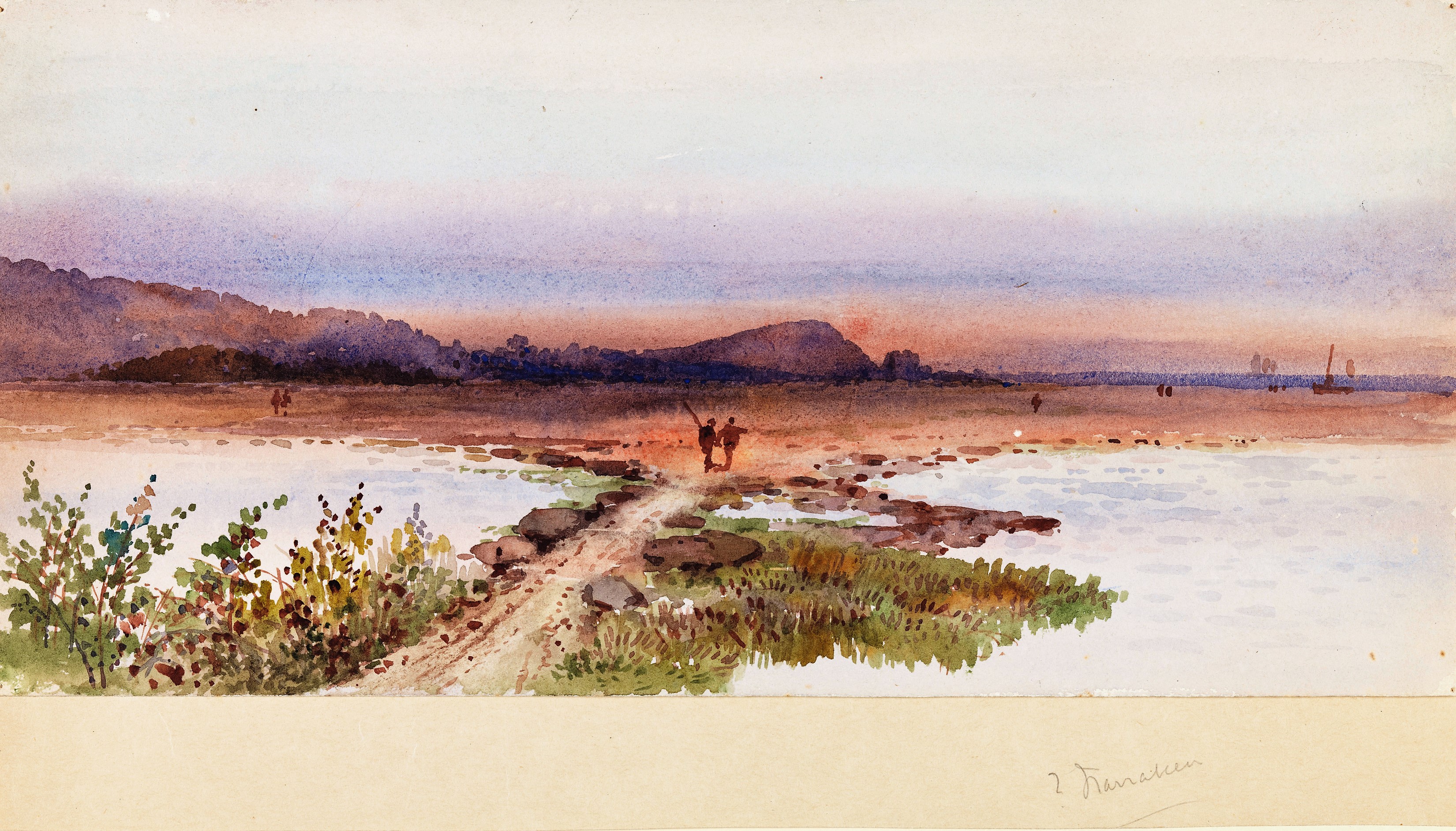
Narrabeen [a view, possibly of the lagoon and beach] Watercolour, 16.2 × 34 cm (6 3/8" × 13 3/8") circa 1870 by William Andrews, 1840-1887. Image No. c12838_0017_c, courtesy State Library of NSW
A description of then from a newspaper report of 1877:
SCENE ON NARRABEAN LAGOON.
Narrabean And Mona Vale.
THERE are few spots about Sydney more picturesque and interesting than Narrabean and Mona Vale, Pitt Water, and the wonder is that more visitors from the noisy and dusty metropolis do not find their way to these peaceful sylvan scenes, to rusticate and recruit their flagging energies. Fish abound in the lagoon, and at the present season there is no lack of game in the underbrush near the shore, and the ridges that extend towards the higher country at the back. In addition to this, the character of the whole place is different from anything that is met with in any other part of the metropolitan districts ; and as the eye takes in the prospect afforded, particularly at Narrabeen, one who knows the history of the locality can hardly help being impressed with the idea that it is a picture full of sad memories and mournful recollections. Right before the visitor, as he stands upon the piece of elevated land overlooking the lagoon, extends a fine stretch of grassy country, almost as level as a race-course Though within a few yards of the ocean, not a rock or sign of such proximity is visible, and the whole reach is protected from the violence of storms by a belt of thick forest which margins the ocean throughout. At the back rugged ridges rise precipitously, and these being clad with foliage to their very crown, add much to the sense of beauty and security, as it were, of the whole place. Hereabout are evidences of a once busy time; but desolation now presents itself on every hand. The houses are in ruins, and the fences dilapidated, and one sees nothing now but what indicates a marvellous chance from the past; remnants of once comfortable homesteads show themselves, and time indeed seems here to have destroyed all that the energy and industry of man once sought to produce or rear up. Turning round, and looking in a north-easterly direction, an enchanting view meets the eye.
Our artist has endeavoured, in the accompanying engraving, to depict some of its beauty. Almost at one's foot the placid waters lie like a mirror, over an area of several miles, till the ridges push in their rugged outlines on either side, and thus intercept the view ; but then, farther on, the eye catches a glimpse of a piece of cultivated country, where, one would think, a man might dwell in peace and quiet all his days. To the right the lagoon extends towards the ocean, from which it is separated by a sandy bar, which, however, allows of overflow one way and the other according to the circumstances of the hour. Cranes and aquatic birds abound, but there is very little sign of human life during the greater part of the year. At certain seasons, however, a few fishermen come to the place for a few weeks' stay, and with the aid of their boat and net are able to make the visit profitable. Our view shows their boat upon the lake, moving silently along as a thing of life.
No more enchanting sight presents itself than this when observed at an early hour- as day breaks, and the gloom disappears, and each headland and bay is lit up, and the whole scene which lies before the eye presents a magnificent panorama of undisturbed nature. Turning again to the ruins, one wonders why such a spot should be I deserted, and the mind is by degrees induced to picture the past, and ask where are those busy hands that first broke in upon this silent scene-that in old times toiled and toiled from day to day beneath the burning sun, to gather about them the comforts of civilisation - all scattered or fallen into disrepair and ruin. Each stone has its history, and the decayed and tottering posts erected by industrious hands tell of the men who have long since passed over to the majority.
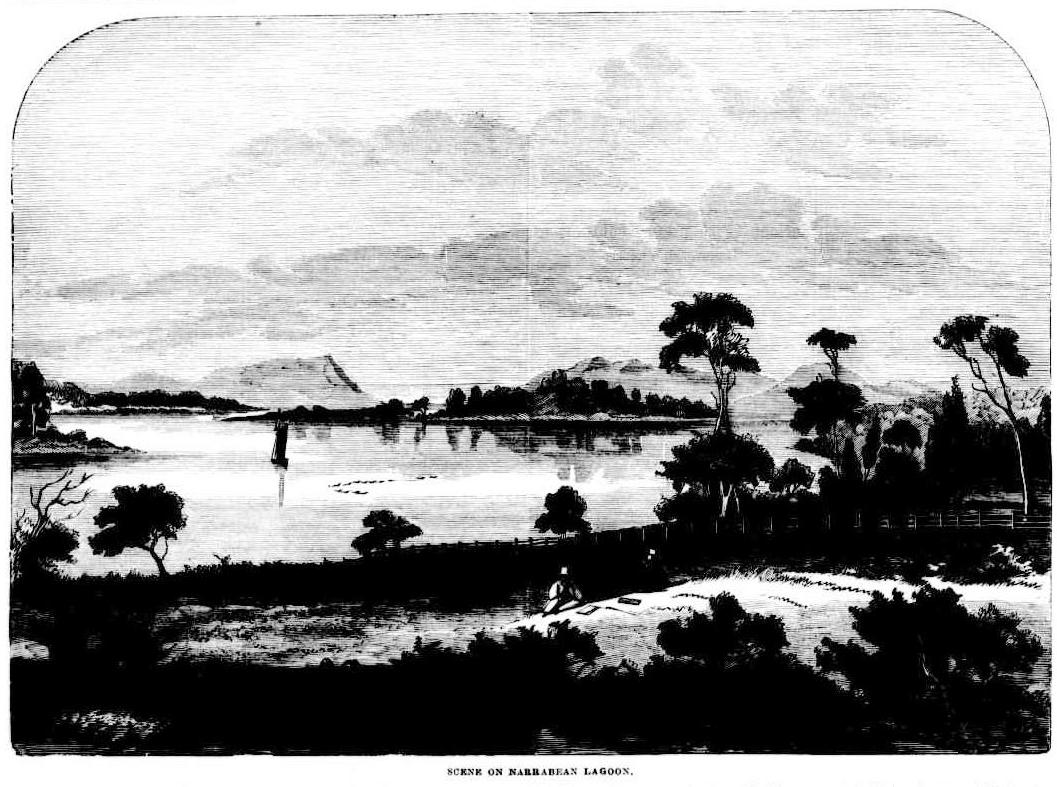
But all must be left to the imagination ; there is no one about to reveal the past; nothing seems to live or flourish, save a gigantic cabbage-tree, which rears its head fifty or sixty feet, and, defiant of both time and tempest, looks complacently down on the surrounding scene of desolation. Of late years the place has been in the possession of the Jenkins family, whose members have won for themselves the esteem of all the residents of the district, and whose generous hospitality is spoken of by every one who visits Narrabean. Their homestead is situated a short distance in from the coast, at Long Reef, and its unobtrusive yet comfortable appearance reminds one of an English country home.
The land at Narrabean is not now cultivated; the soil has been worked out long ago, but a few sheep and cattle are frequently depastured there. Wherever one looks in this district, the scenery presents an aspect totally different from what is usually met with on the coast, as here is found a long stretch of land within a stone throw of the ever-rolling ocean, originally of great fertility, but exhausted by long cropping and careless cultivation. It is much the same with the Mona Vale estate, which is situated about three miles on the opposite side of Narrabean, and usually reached by crossing the lagoon in its shallowest part, which is about the centre. As one wends his way along through the bush, and Mona Vale opens out before him, he stands to behold and enjoy the novel view that presents itself ; it is so secluded and quiet, and yet so grand, with the rugged ridges on the one hand, and the turbulent ocean on the other, that it singularly impresses the visitor, who becomes eager to learn its history, and feels sure there must be many pleasant reminiscences to tell of past occupants. What a sad mistake ! What fearful trials and losses and disappointments have been experienced here. Its history should be written in blood, for if ever red-handed crime flourished in any country, it flourished and triumphed here, till it brought ruin and death to honest people ; and justice, outraged beyond bearing, rushed in and brought the delinquents to punishment. The description of these places has already taken up all the space that can be afforded, so we must defer till a future opportunity a brief outline of the leading incidents in their history. Narrabean and Mona Vale. (
1877, January 6).
Australian Town and Country Journal (Sydney, NSW : 1870 - 1907), p. 20. Retrieved from
http://nla.gov.au/nla.news-article70598057
The age old problem of increased population attracting increased funding for infrastructure such as roads met a catch 22 situation in the turning of tracks into passageways that could be ridden or, when automobiles came along, be driven along. Limited access meant roads remained in a poor condition, were unsealed and in places, not navigable. Add to this the great font of creeks, lagoons and waterways that required bridges and the problem of access persisted into the 1920's, as some articles noted, while others were used to promote the wonderful aspects of the area as a means to attract more people -
'The Wonders of Warringah' - February 1st in the
Sunday Times, is just one example of these.
Deputation after deputation 'waited upon' a minister for roads, for bridges, for connecting old tracks to new tracks;
Narrabeen Lagoon Crossing Place - 1880
Pittwater scenes, 1880 / Harold Brees, LNarrabeen Lagoon Crossing Place - 1880, Image No.89644600, courtesy State Library of New South Wales.
PITT-WATER ROAD.
The same Minister was waited upon on Friday by the Mayor of Manly (Mr. Hilder), with Messrs. Hayes and Barker, who asked the Government to put in repair that portion of Pitt-water-road, running through the municipality of Manly, before the management of the road was taken over by the municipal council. Mr. Lackey informed the deputation that the Government had already made provision for the work being performed. PITT-WATER ROAD. (
1880, March 13).Australian Town and Country Journal (Sydney, NSW : 1870 - 1907), p. 27. Retrieved from
http://nla.gov.au/nla.news-article70941827
A Bridge over the lagoon - what? Finally:
NARRABEEN BRIDGE.
Mr. LACKEY, in reply to Mr. Furnell, stated that a sum had been noted for consideration of the Cabinet for the erection of a bridge across the Narrabeen lagoon.
Mr LACKEY in answer to Mr Teece, said that tenders for a bridge over Narrabeen Lagoon, close to the present road, would be invited in two weeks. PARLIAMENT OF NEW SOUTH WALES. (
1882, September 9).
The Sydney Morning Herald (NSW : 1842 - 1954), p. 9. Retrieved from
http://nla.gov.au/nla.news-article13526176
A description of the road and way through Narrabeen lagoon of then:
The Sketcher.
A Trip To Gosford.
Leaving Sydney by the 7.15 a.m. steamer for Manly, one discovers how pleasant and refreshing a trip down the harbour may be on a crisp September morning, and regrets on reaching Manly that there are but some 15 or 20 minutes allowed for satisfying the sharpened appetite before the Pittwater coach gets under way. Bowling round the corner, the team, fresh as two-year-olds, takes us at a merry pace along the level road, past the lagoon, and into the bush, continuing amid rock and scrub that grows so prolifically in this sandy soil. A fairly good road gradually ascends for several miles, the left being a mass of rough broken country, and the right, some high ground shutting us off from the sea, till presently we come almost on to the sea-shore, and every hill we top gives as a view of the continuous bay and headland coast-line stretching ahead for miles.
The road seems to end here, and the coach enters upon a level strip of sward overawed by a straight range of steep, rocky hills, with a cabbage tree on top, limned against the sky. Here, meeting the fresh north wind that lifts the horses' manes, the leaders put their heads down and stretched themselves for a canter. I had been especially directed to select this route on account of the beauty of its scenery, so closely resembling, at times, that of the Rhine. But although one part of Europe may frequently recall another to the recollection, yet in Australia nature has assumed such distinct characteristics, that all comparison is rendered out of the question, nor could any effort of the imagination convert the old stone ruins on the rise at the end of the flat into the remains of some castle of romance. We could not elevate oneself above the conviction it was but a settler's or free selector's home-stead. Recently the land about here was sold, fetching prices up to £10 for quarter-acre blocks.
A little further on we entered Narrabeen Lagoon, when the water came over the bottom of the coach. For three quarters of a mile the coach struggled along through marsh and water, not daring to stop lest the wheels sink in the sand. However, it is understood the Government will call for tenders next month for the construction of the bridge.
Coming out of Narrabeen the coach passes round a finely formed hill abundantly clothed with tree and fern, including quantities of the Burrawang species. On the left arises a cleared eminence with two red cattle; beyond, a half-cleared flat, with a mass of low gnarled gum trees in front, through which the road leads ; on the right are some stretches of white sand, with a reddish-brown bluff rising above, and splashes of spray dashing up against it ; a few light clouds above break the sunshine. It is a good specimen of natural Australian landscape, and these are to the picture the finishing touches of the artist's master hand. As a centrepiece of such a scene, none but a painter knows the value of a lumbering coach and four, axle deep in water, slowly dragging its way along.
From Narrabeen to Pittwater is a succession of hills and gullies, the views, and retrospect from each becoming finer and finer.The aspect of the coast, which is now continuously in sight, suggests somewhat the snapped off red clayey cliffs of Devon ; while two or three miles beyond are seen the deep gorges among the hills that hide the lake of Pittwater. From a distance, the rugged boldness of the hills bear many of the characteristics of mountainous parts of the Black Forest, although when close the vegetation and the general appearance of 'unfinishedness' effectually dispels the illusion.
Presently we approach a promontory with rounded top and sides, smooth shaven like a lawn, and interspersed with scrub like the soft buxom furze of a Cornish hillside. It is remarkable besides for its massiveness, and one feels on reaching the summit as though he had overcome one of the obstacles of life. At length, reaching the eminence above Pittwater, we take our last view of the ocean with its half score of white sails dotting its wide surface in an aimless sort of way, and call each other's attention to the dignity waves can assume as they come rolling in with a slow lazy sweep and curl and break on the curved sandy stretch that connects the protruding frowning headlands.
Turning inland, we enter, as it were, the top rim of the basin of the lake, and suddenly come upon the loveliest spot between Sydney and Brisbane Water. On the left one looks down a gorge ever so steep down: down through the stems of several species of gum, ironbark, mahogany, forestoak, turpentine, and cabbage tree, their tops netted into a dense mass of foliage, their bases buried in a profuse overgrowth of fern, bracken, clematis, and the graceful burrawang, a species of palm-fern, while in the mid-distance between the tree stems one can trace the stream at the bottom. The scene is rich with the luxuriant beauty of a New Zealand pass. Coming round the shoulder of the hill, openings in the trees betray glimpses of the deep blue waters of the lake, while the scene stretches away beyond to the high enclosing hills, in all their deep colouring, like one of Conrad Martens' pictures.
A few minutes more, and the coach stops at the Newport Hotel, having accomplished the 14 miles in about two hours. At the waterside awaits the steamer Florrie. A little to the right, in a small bay, is another wharf, with a large house close by approaching completion, and destined for a boarding-house. As we steam out, we wonder which way we shall take, for the lake is completely landlocked by huge bluffs rearing themselves up above us like so many 'Ball's Heads,' and suffering rough jagged gorges to penetrate their way deep into their mass. In several places where the nature of the ground allows settlement, cottages and gardens and orchards have sprang up, and their beauty of situation renders one envious of the owners.
Bending to the right, we pass between Lord Loftus Point and Scotland Island, while far ahead, near the heads of Broken Bay, is seen the noble island, in shape like a couchant lion guarding the entrance as he faces it. Pittwater forms a magnificent harbour, and, undoubtedly, in due time its waves will reflect the lights of a grand city reared upon its banks. Its entrance, some three miles wide, is wondrously safe. Its waters are deep, absolutely sheltered from every quarter; and as to its size, would float the navies of the world. Pittwater is the southern arm of the estuary, Brisbane Water the northern, while between, straight in from the Heads, stretches westward the grand outlet of the Hawkesbury River, between two enormous banks. Few rivers can match its magnificence of debouchure, as the hills boldly approaching the ocean in all their pride of strength majestically deliver up the waters confided to their charge. At the Barrenjoey lighthouse, whence also a cable is laid to Brisbane Water, we come in sight of the entrance to the harbour, and as we cross have a full view on our left of the estuary of the Hawkesbury. ...SYDNEY. The Sketcher. (1882, September 30). The Sydney Mail and New South Wales Advertiser (NSW : 1871 - 1912), p. 542. Retrieved fromhttp://nla.gov.au/nla.news-article161926095
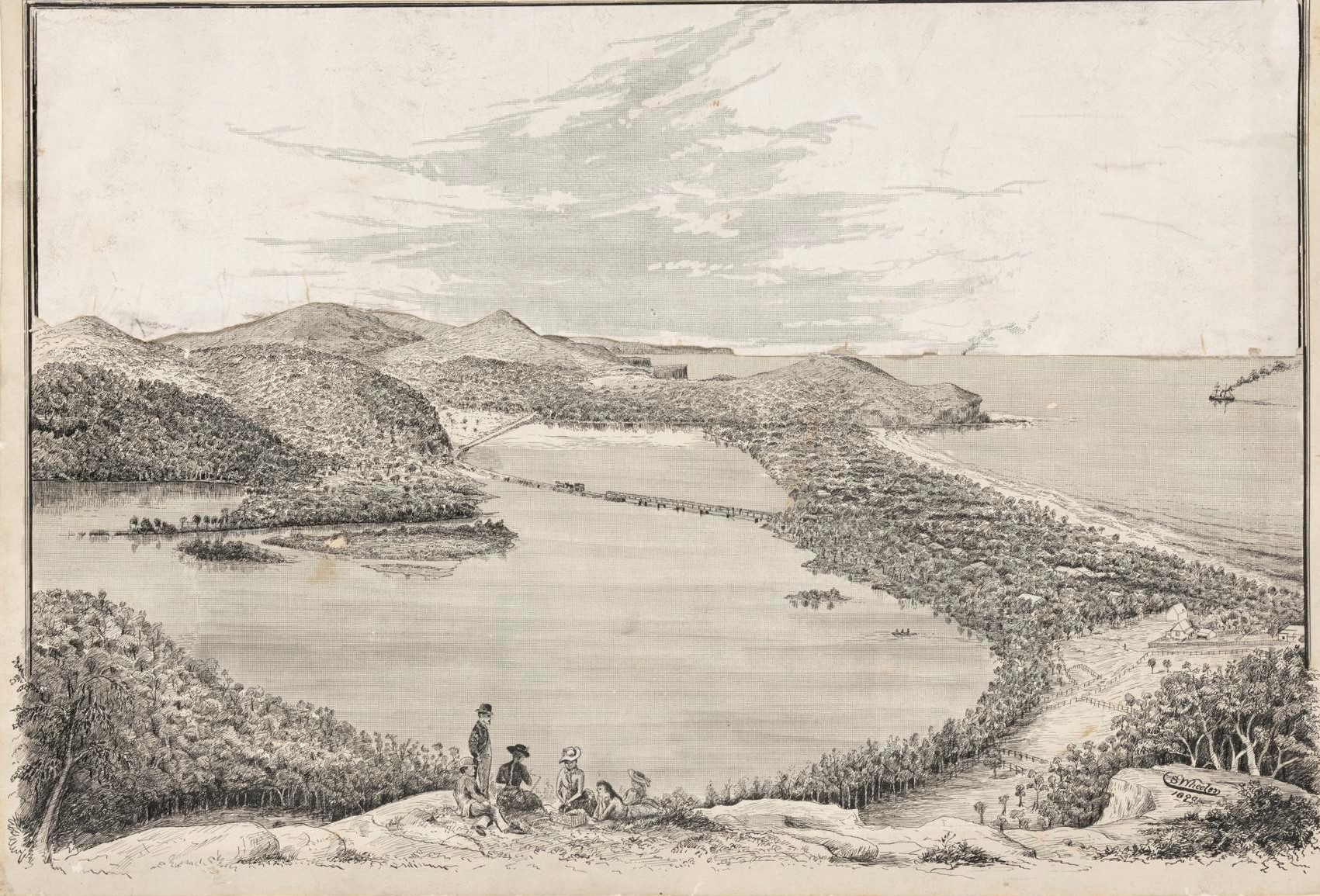
Narrabeen Lagoon, 1890/ C. S. Wheeler (or Wheelen) - Part of the drawing appears to have been done by a silkscreen process. The section showing the sky has been replaced by a glued sheet.Image No.: c11295_0001_c - courtesy Dixson Library, State Library of New South Wales
THE NARRABEEN LAKES-A PICTURESQUE HEALTH RESORT NEAR MANLY. (See letterpress on page 19.) Manly to Broken Bay. (1893, November 11). Australian Town and Country Journal (Sydney, NSW : 1870 - 1907), p. 30. Retrieved from http://nla.gov.au/nla.news-article71191632 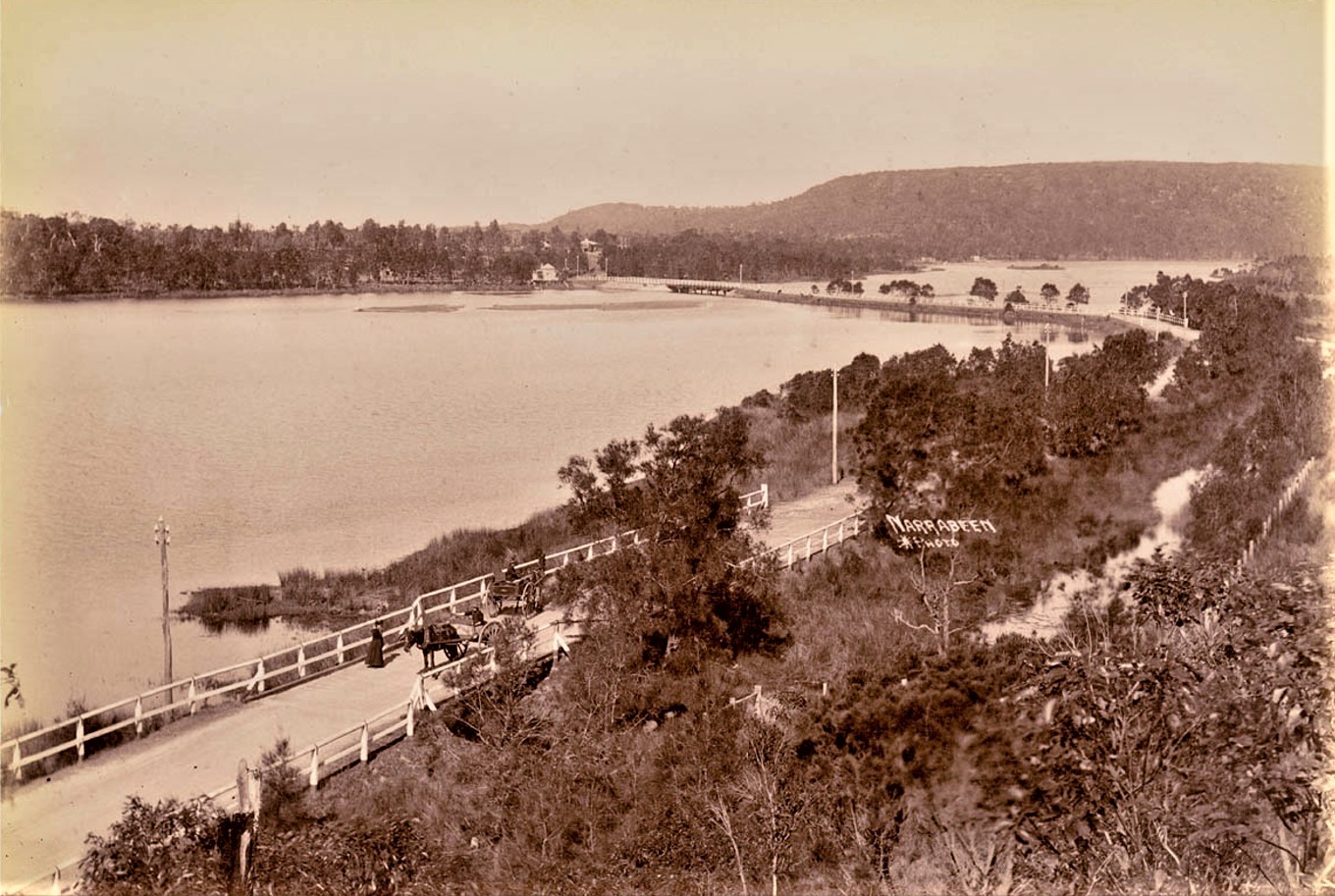
Narrabeen, Star photo, circa 1900-1906. Item a116483h courtesy State Library of NSW
Narrabeen 'road bridge' - postcard, from the collection of Josef Lebovic Gallery collection no. 1, courtesy National Museum of Australia - circa 1907 to 1913
'View taken near Narrabeen on the road to La Corniche' - Sunday September 17th, 1911. Image No.: a3289060h from Allen family albums, courtesy State Library of NSW
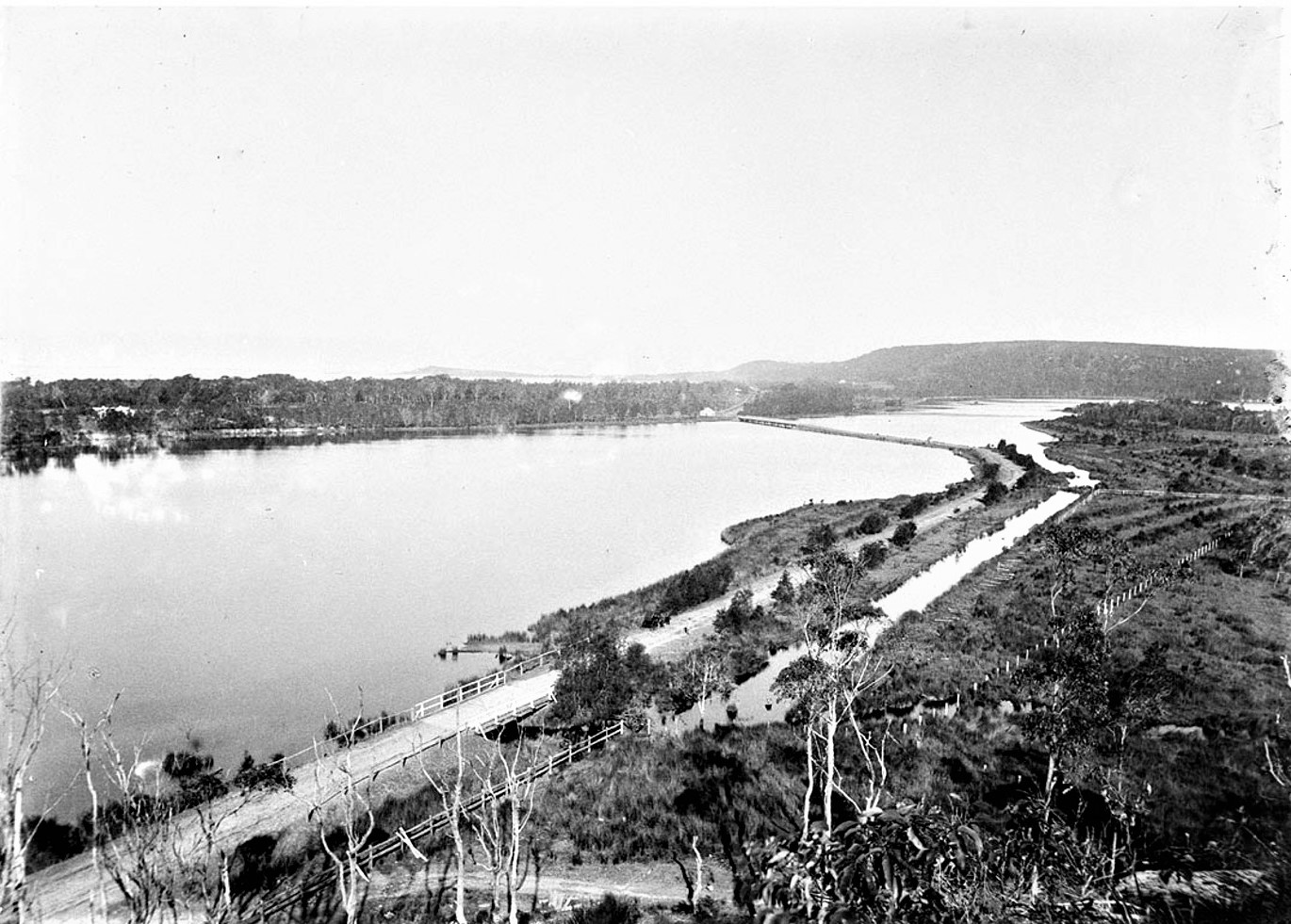
Narrabeen lagoon, circa 1915, Item hall_34703h, courtesy State Library of NSW
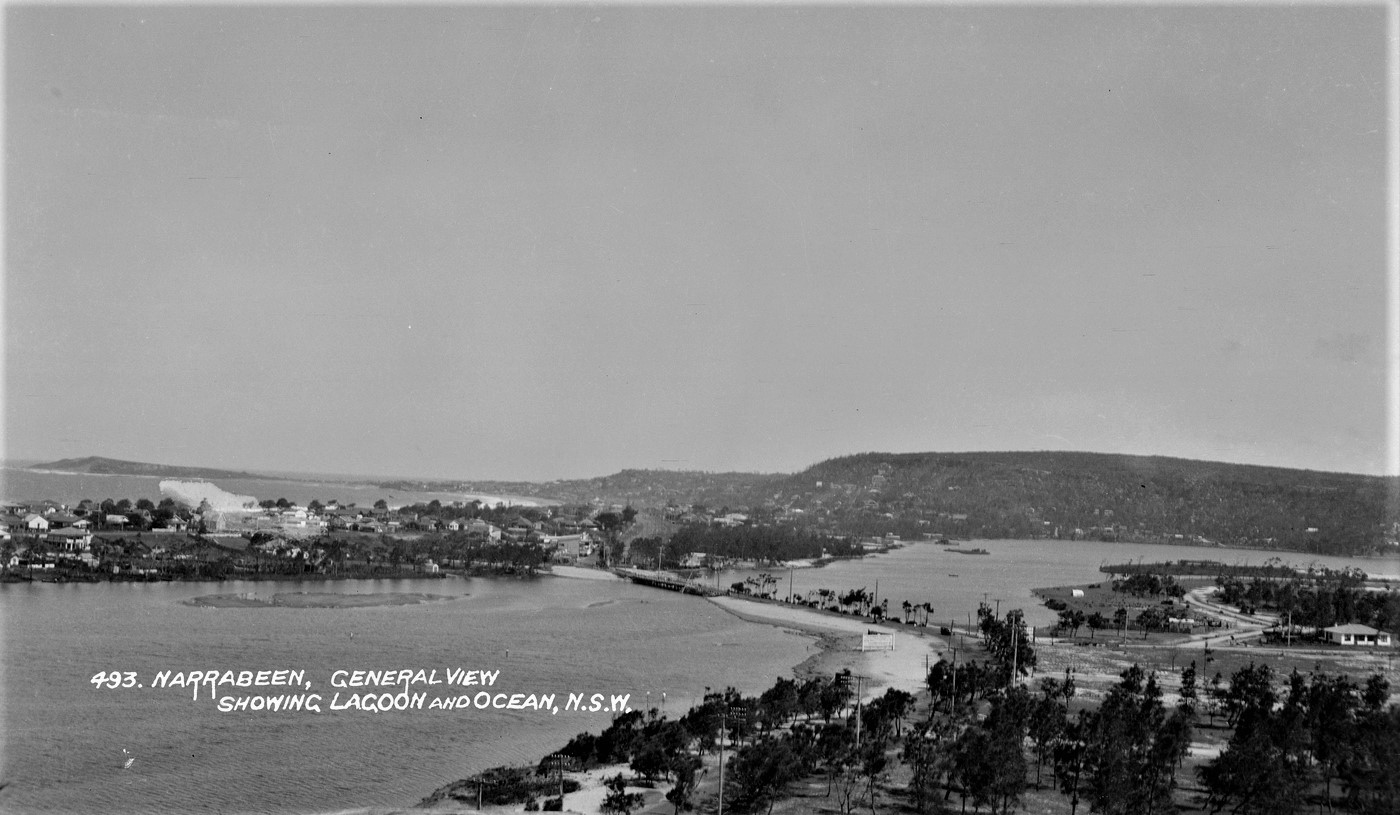
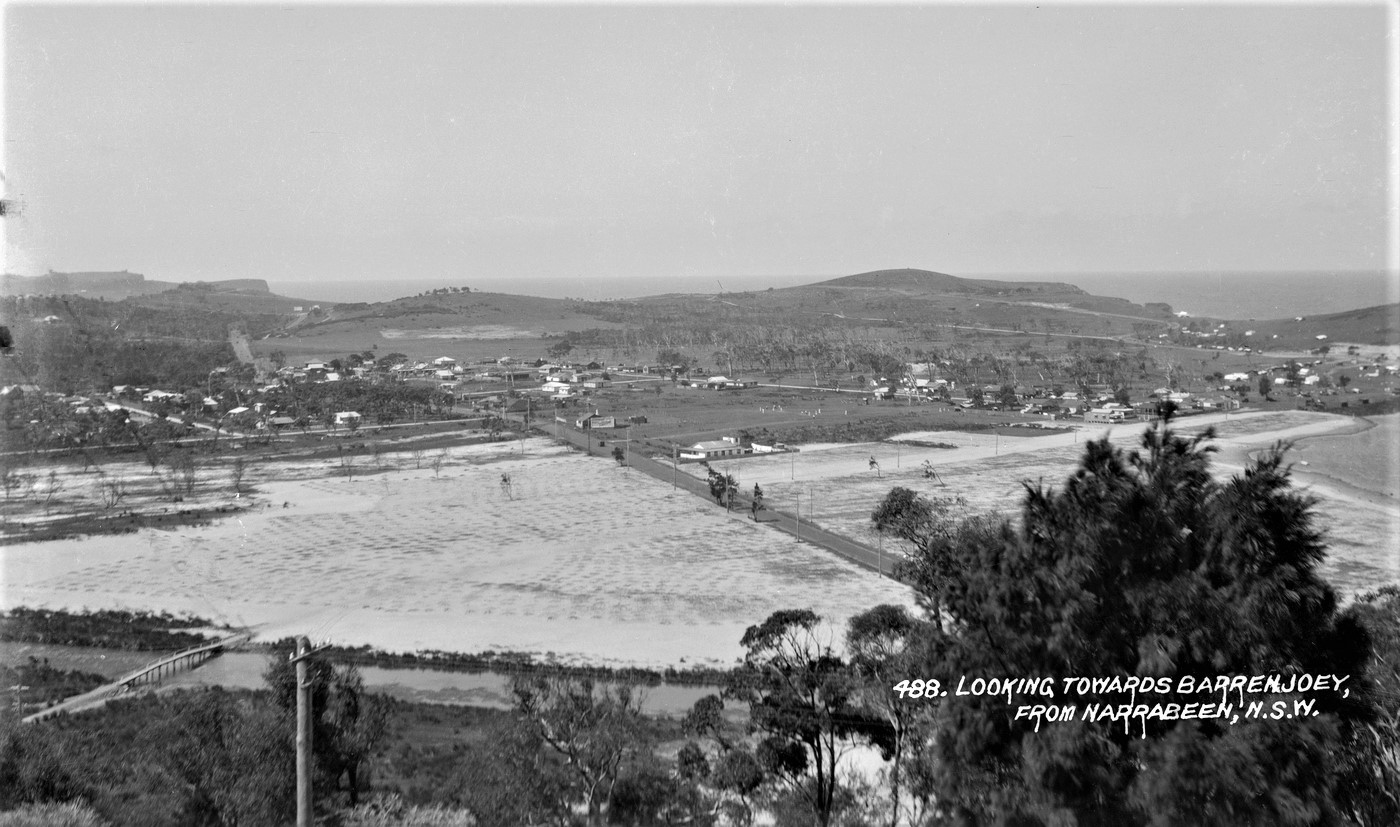
Narrabeen Lagoon, General View showing Lagoon and Ocean and Looking Towards Barrenjoey, From Narrabeen circa 1927, from Album 'Samuel Wood - postcard photonegatives of Narrabeen,' - Items a1470096h, a1470091h, courtesy State Library of NSW
A MOTOR CAR ON THE PITTWATER-ROAD, NARRABEEN
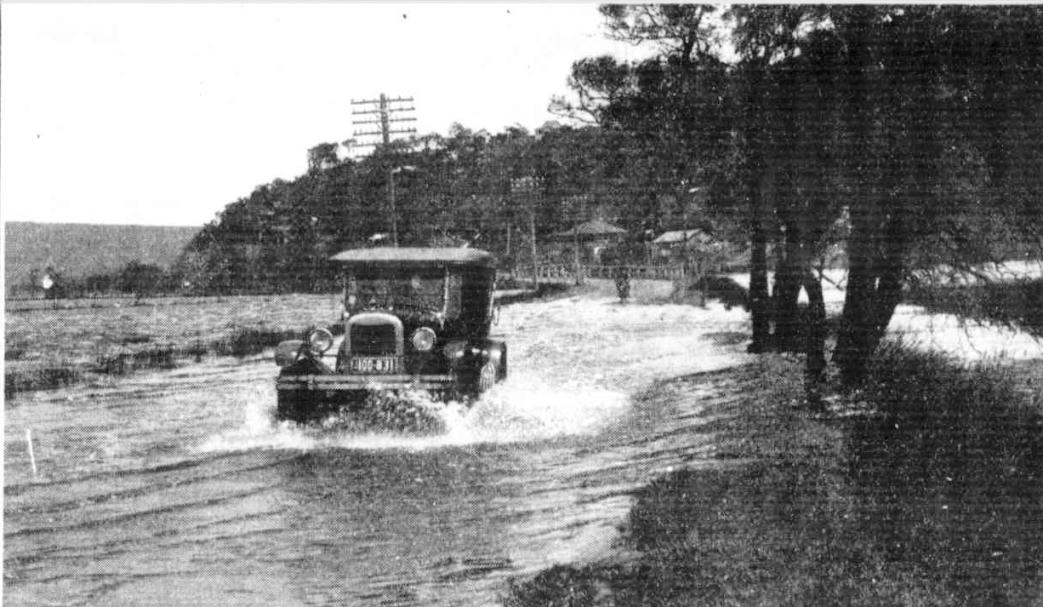
The foreshores of the lake were flooded by the recent heavy rains. The Warringah Council workmen opened a way to the sea on Sunday morning. Forestry, Floods, and Kindergarten Work (1927, November 30). Sydney Mail (NSW : 1912 - 1938), , p. 9. Retrieved from http://nla.gov.au/nla.news-article158295859
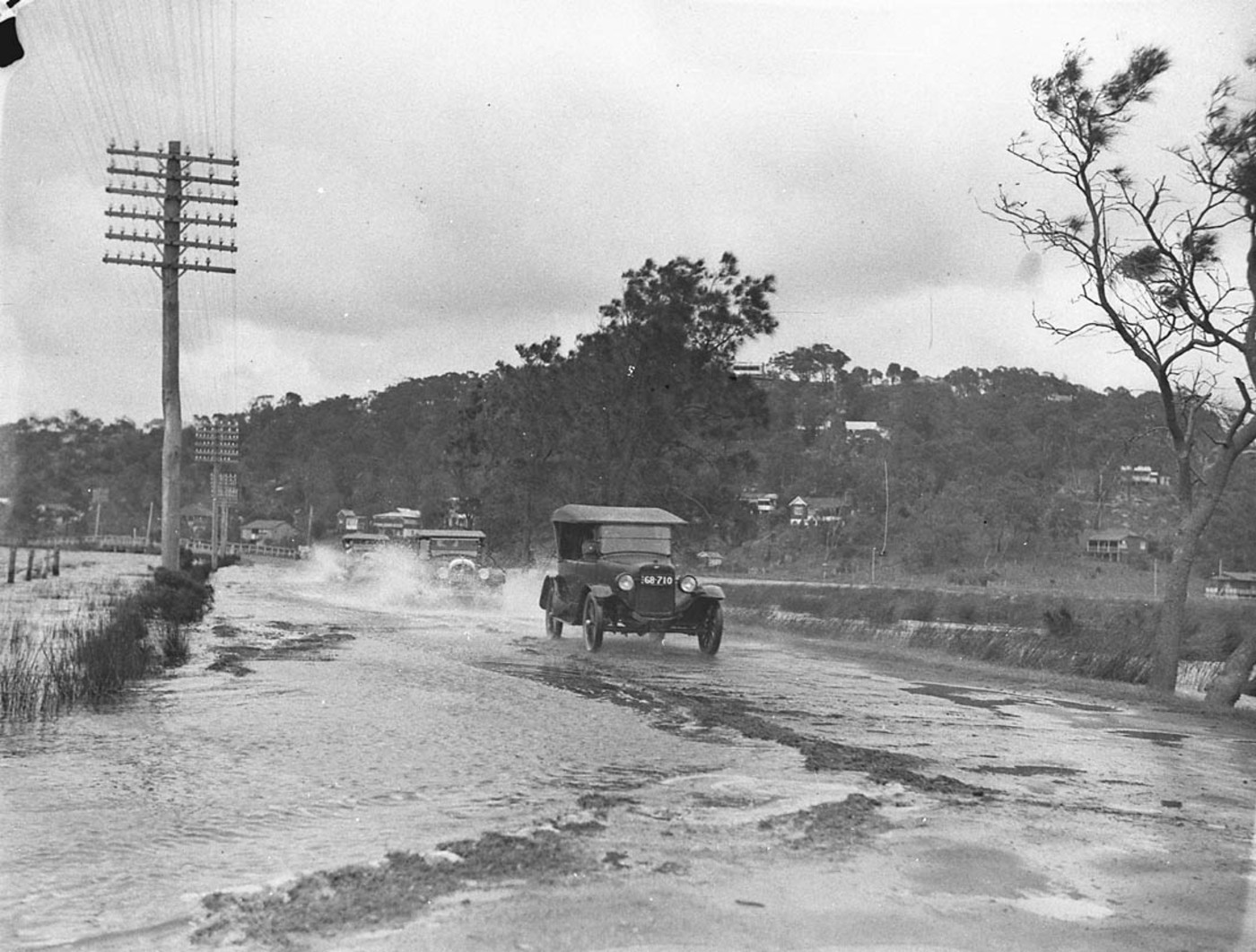
A 1926 Overland, a 1928 (?) Chrysler, and a 1928 (?) Dodge ploughing through Narrabeen floods - November 1927 Image. No: hood_06391- from the collections of the State Library of NSW.
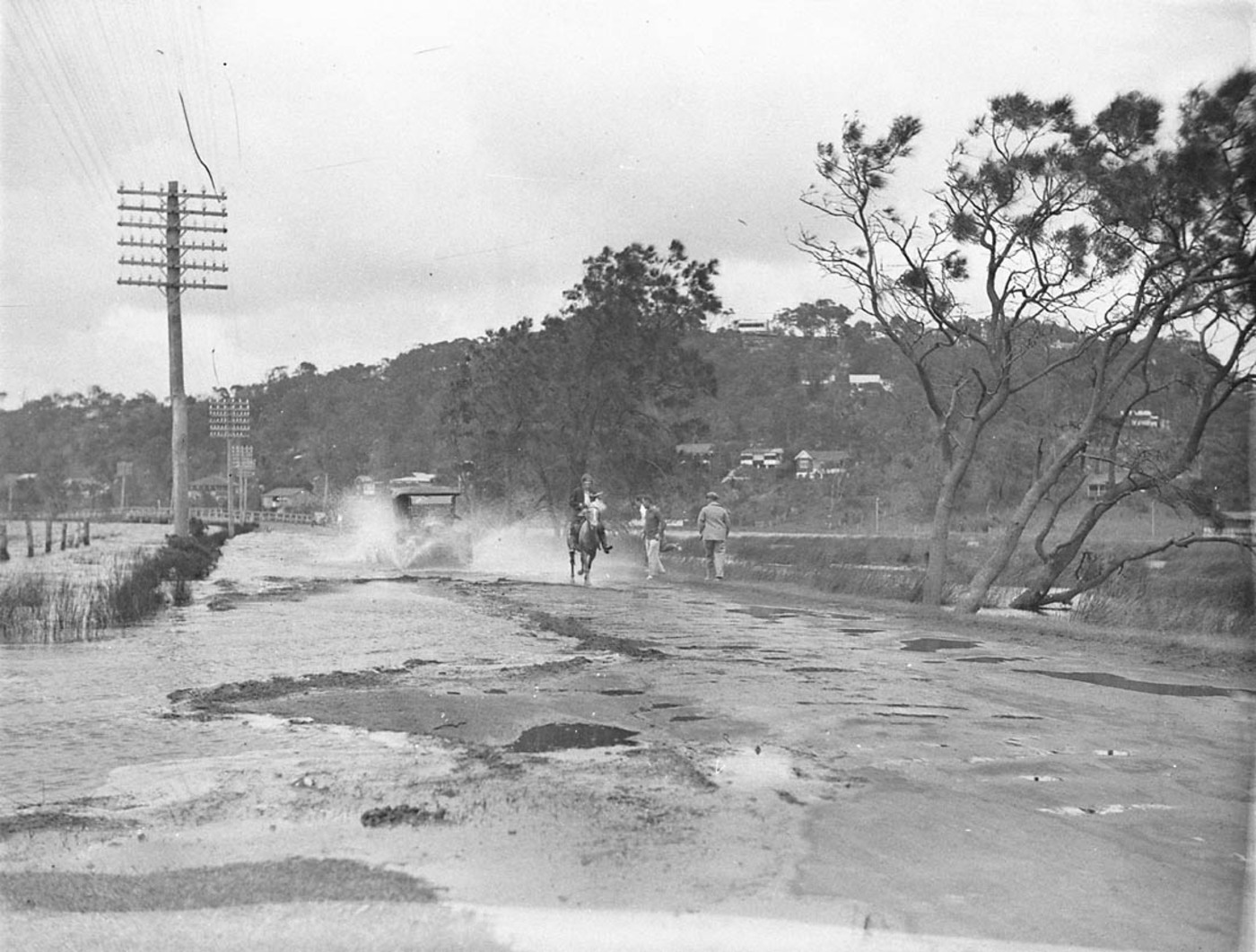
A car and a horse plough through a flooded road, Narrabeen - Image. No: hood-006394 from the collections of the State Library of NSW
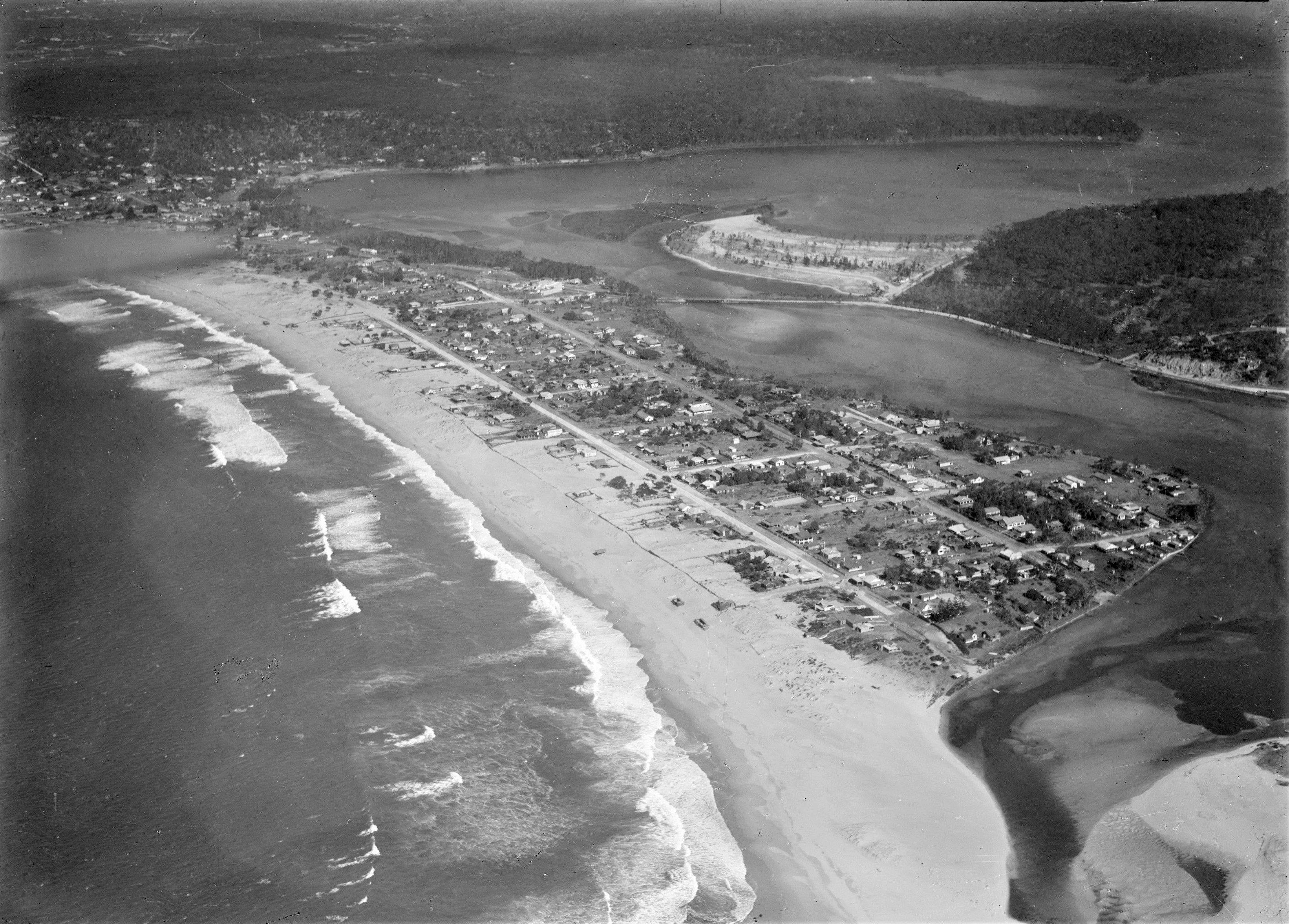
Narrabeen Lagoon aerial, from album ''Milton Kent aerial views of Bondi, Cronulla, Granville, Haberfield, Middle Harbour, Narrabeen, Mascot, Sydney, Sydney Harbour, Tempe, circa 1928, Item: c111660015, courtesy Mitchell Library, State Library of New South Wales - and sections from to show details; NB - no Bridge from Ocean street across Lagoon present, and old Nth. NSLSC still on beach.
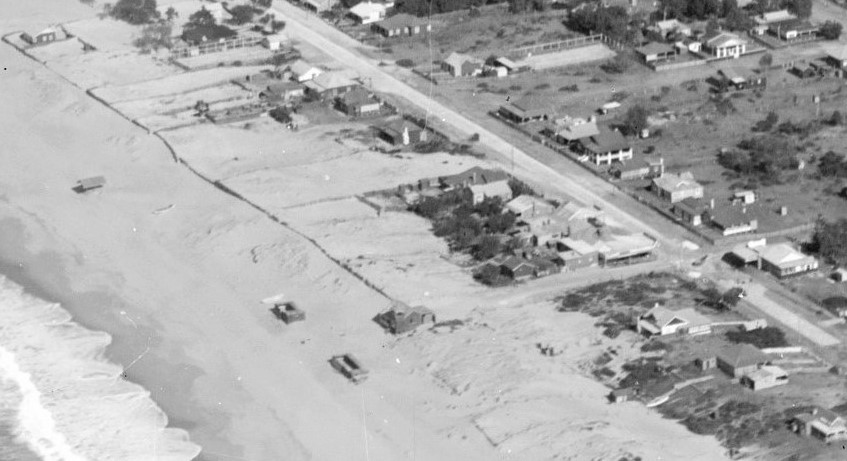
.jpg?timestamp=1593071813851)
Newspaper article above photos appeared in:
Striking Aerial Views : Newcastle and Narrabeen
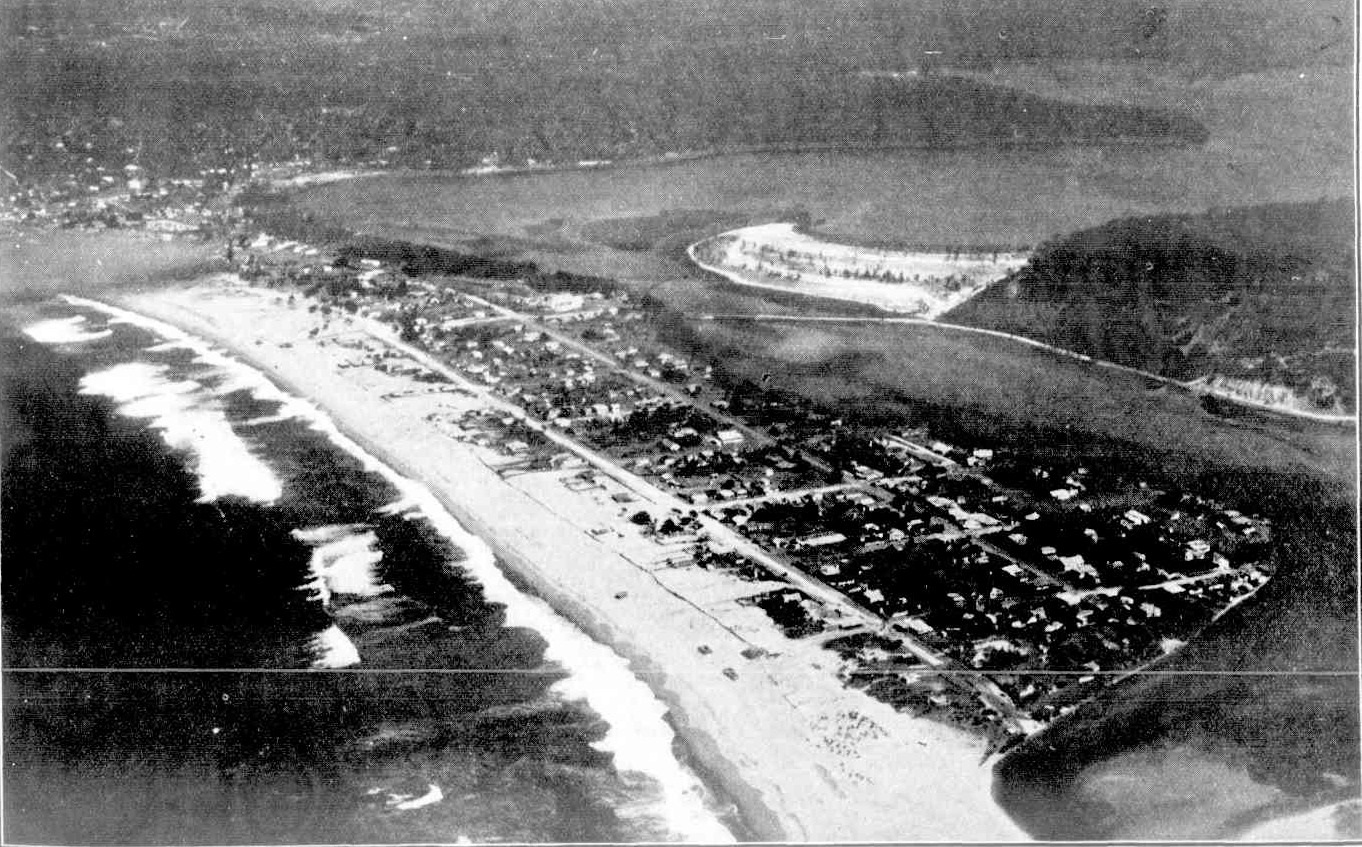
NARRABEEN, BETWEEN OCEAN AND LAKE. This fine strip of ocean beach runs from North Narrabeen through South Narrabeen to Collaroy (on the left). Narrabeen proper is situated on the peninsula in the centre of the picture. The main road from Manly to Newport, Avalon, and Palm Beach runs through the upper portion of Narrabeen, crossing the lake by the bridge, beyond which is seen a portion of low -lying land now being reclaimed. Striking Aerial Views : Newcastle and Narrabeen (1928, August 22). Sydney Mail (NSW : 1912 - 1938), p. 17. Retrieved from http://nla.gov.au/nla.news-article158401835
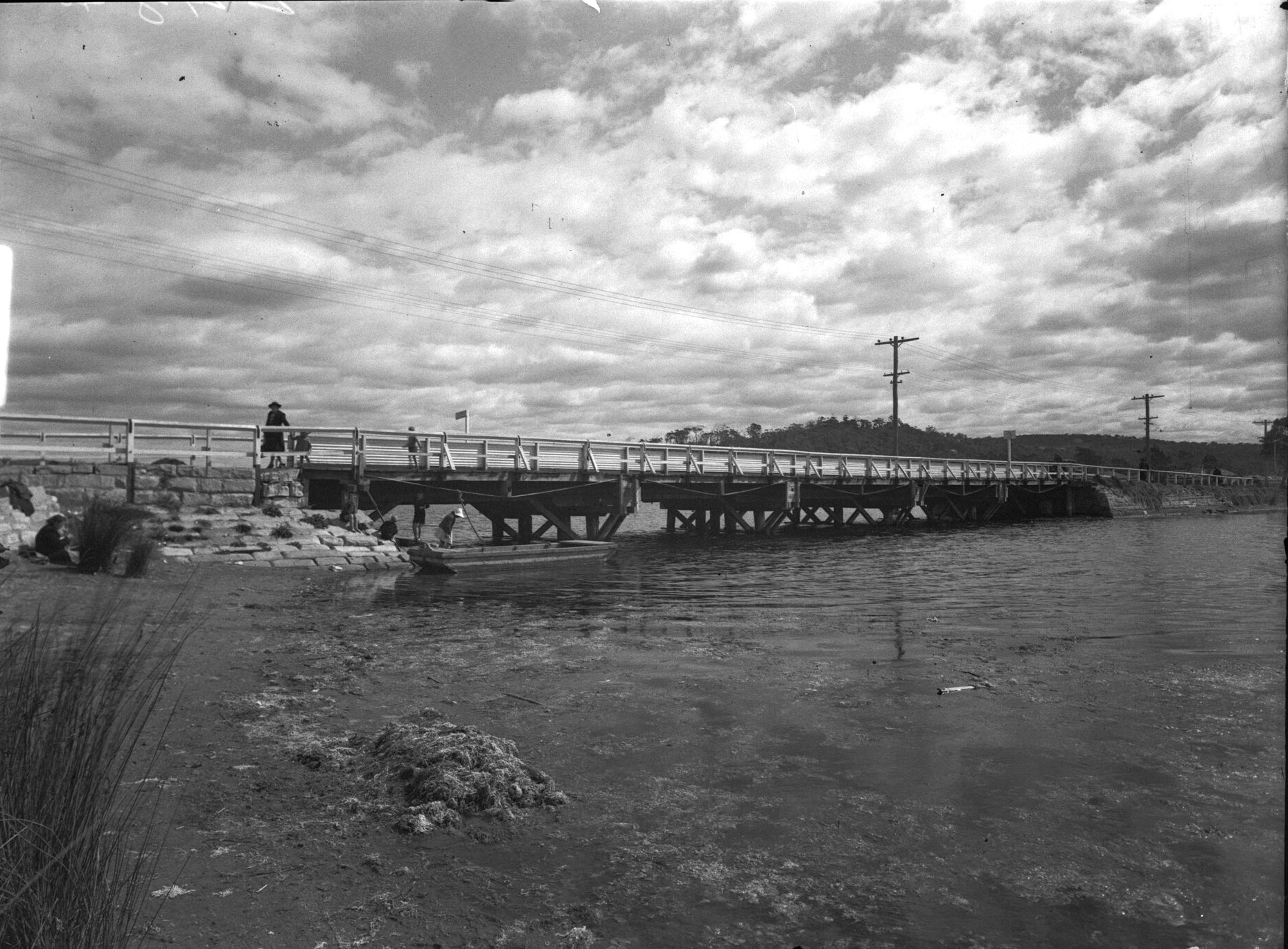
Narrabeen Bridge 1946, Item: FL3794556, courtesy NSW State Records and Archives
Photo: The intersection of Pittwater Road (Main Road No. 164) and Wakehurst Parkway (Main Road No. 397) at North Narrabeen. (From Page 12) 1966-67

 Where the road crosses, the country for some distance around is flat, and consequently tame, and the picture is rendered sombre by the low, thick growth of ti tree that fringes the water line, and the dark leaved honeysuckles of the flat land beyond ; but higher up, where the fresh water of the lagoon commences, where ranges clad with giant timber come down to its margin, and where numerous gullies with the rich, dank jungle vegetation of the tropics, including the cabbage-tree palm, the fern tree, the bengola, and wild vine, empty their watery contributions into it wild landscape views might be taken fully equal to many of those about which artists have raved so much.
Where the road crosses, the country for some distance around is flat, and consequently tame, and the picture is rendered sombre by the low, thick growth of ti tree that fringes the water line, and the dark leaved honeysuckles of the flat land beyond ; but higher up, where the fresh water of the lagoon commences, where ranges clad with giant timber come down to its margin, and where numerous gullies with the rich, dank jungle vegetation of the tropics, including the cabbage-tree palm, the fern tree, the bengola, and wild vine, empty their watery contributions into it wild landscape views might be taken fully equal to many of those about which artists have raved so much.

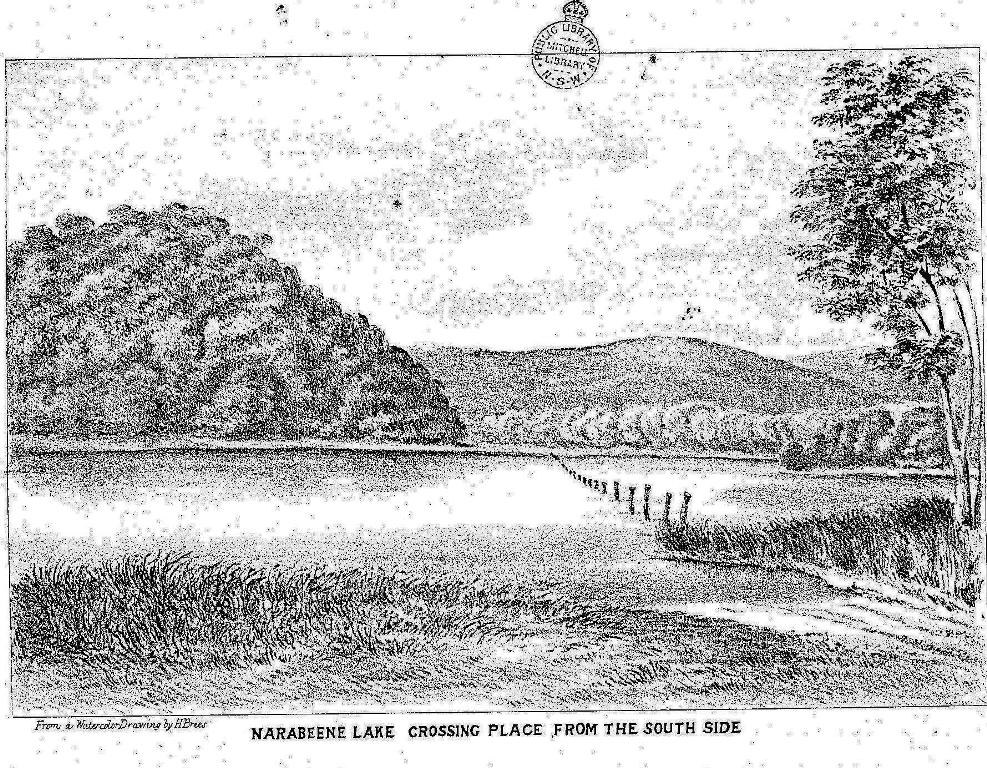
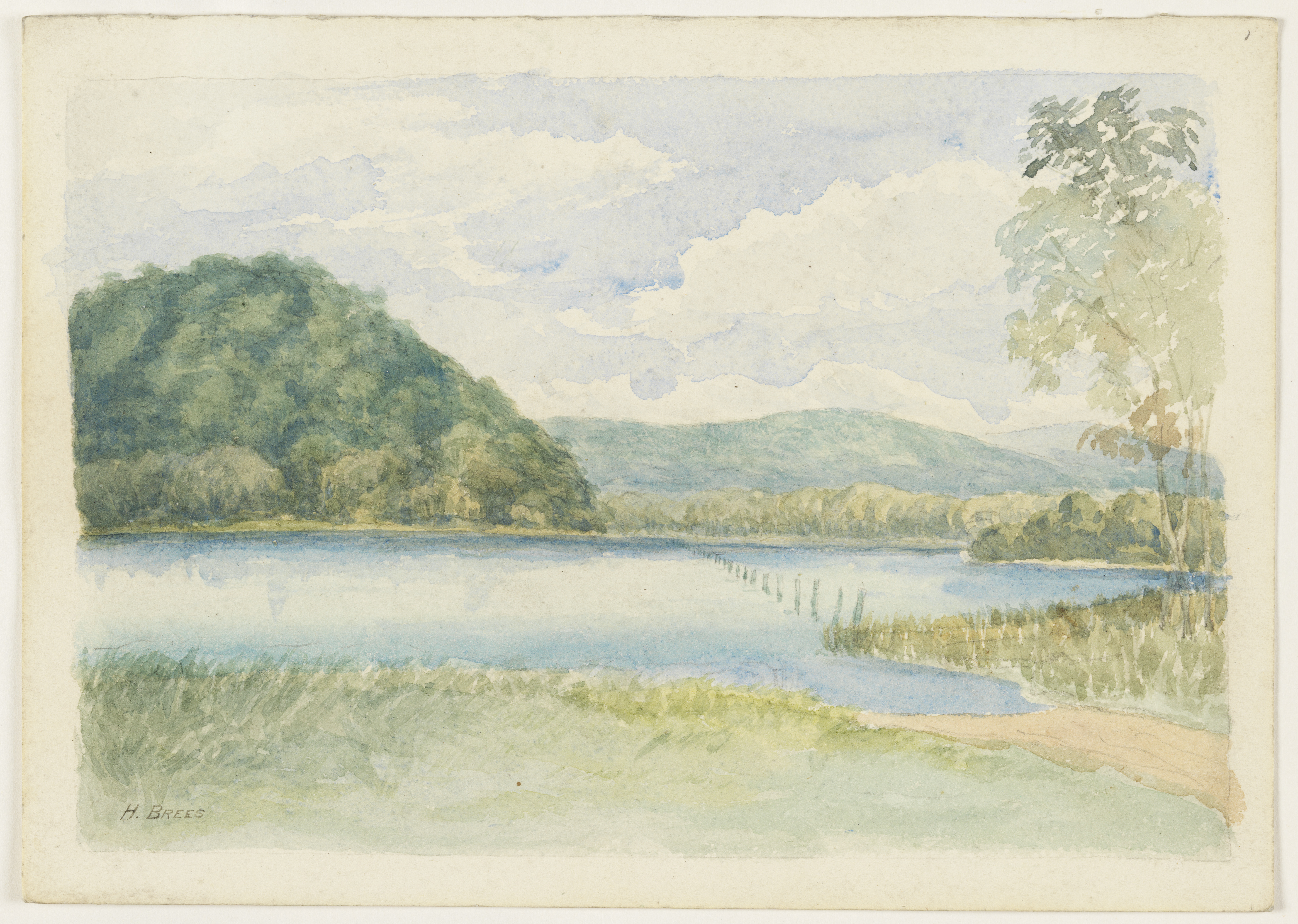

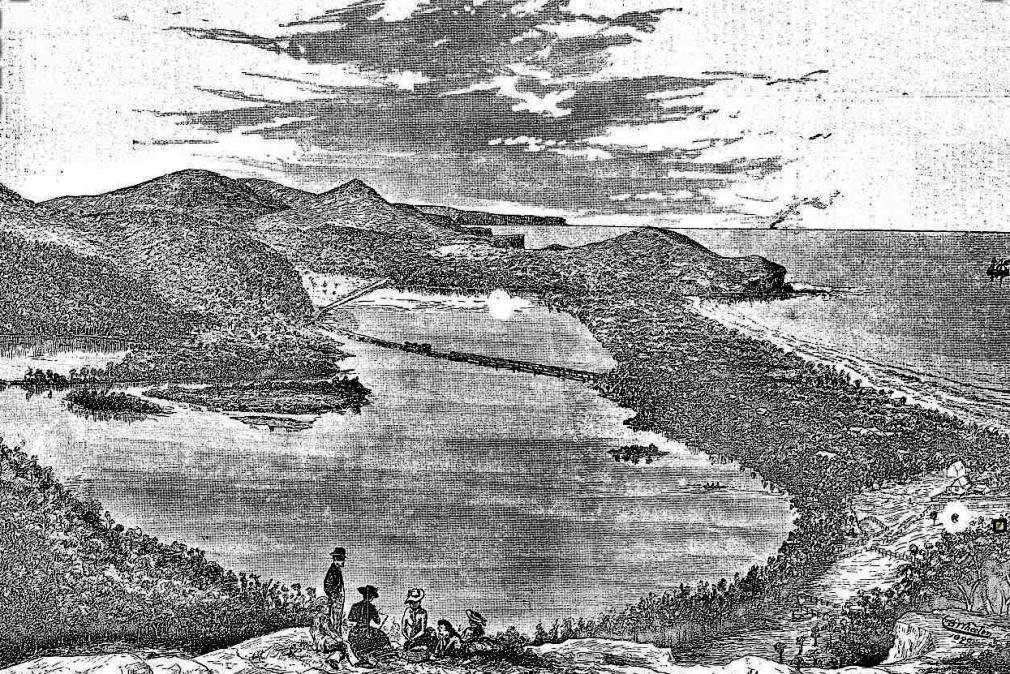
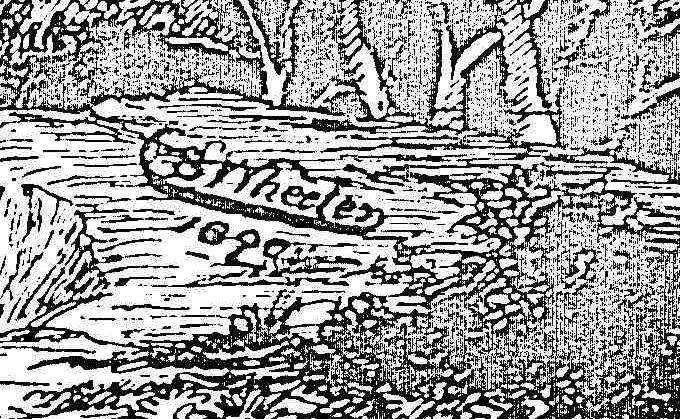

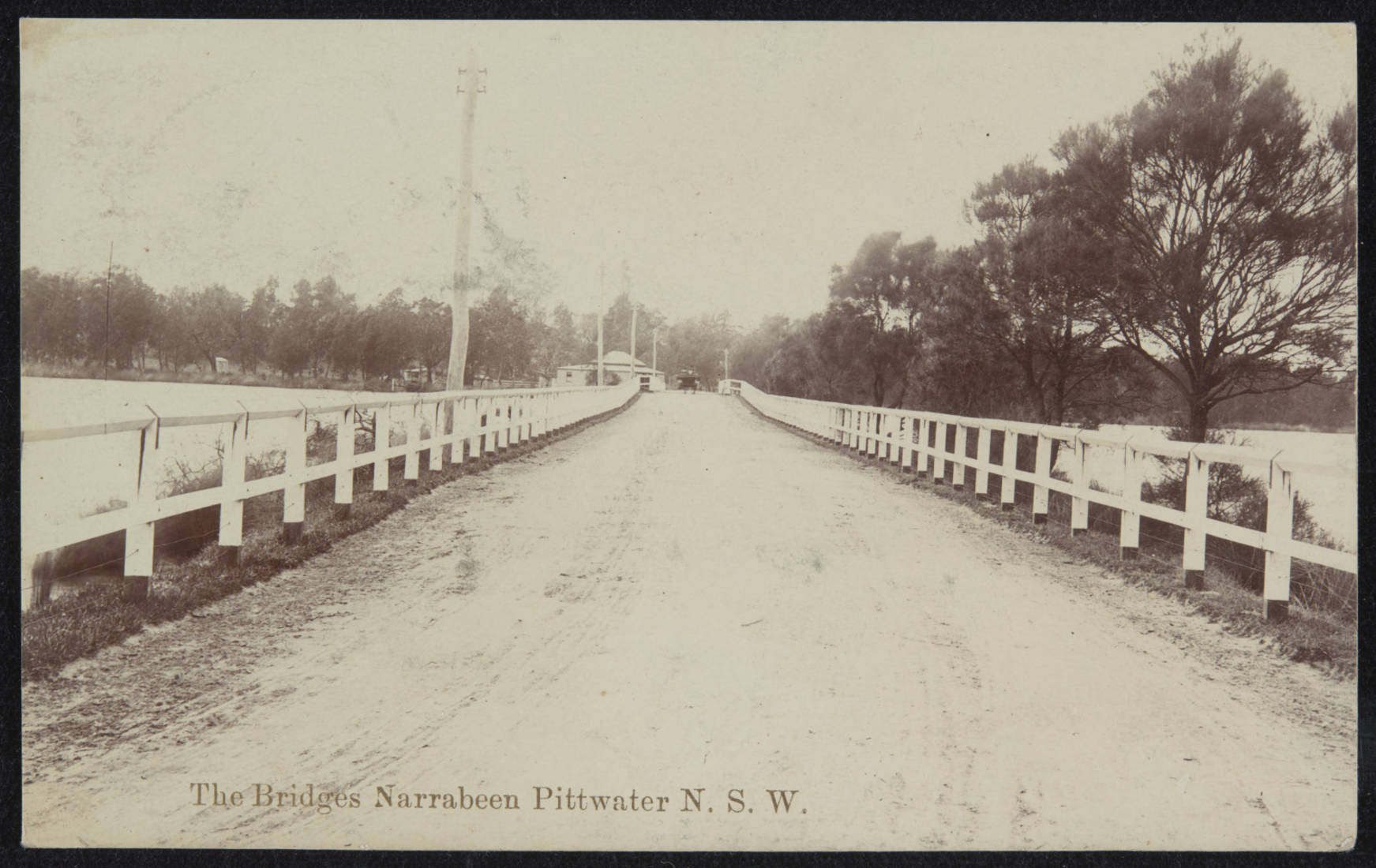
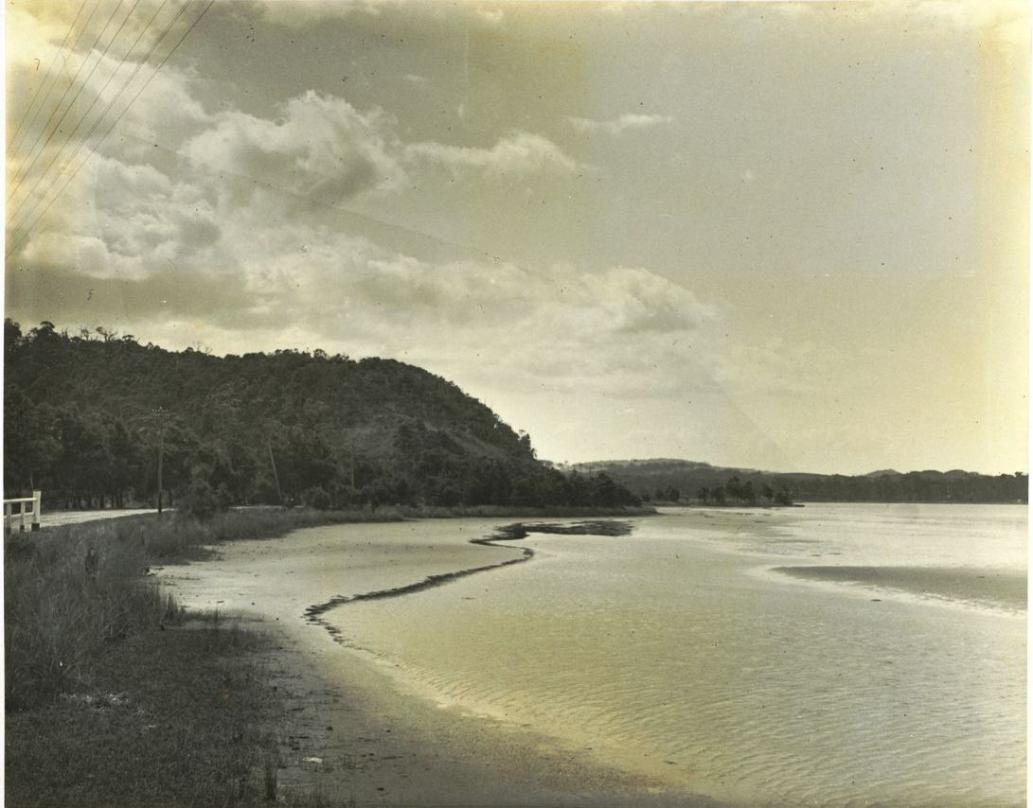








.jpg?timestamp=1593071813851)


